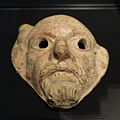Suebian knot
You can help expand this article with text translated from the corresponding article in German. (July 2015) Click [show] for important translation instructions.
|


The Suebian knot (German: Suebenknoten) is a historical male hairstyle ascribed to the tribe of the Germanic Suebi. The knot is attested by Tacitus in his 1st century AD work Germania, found on contemporary depictions of Germanic peoples, their art, and bog bodies.
Germania
Roman historian Tacitus reports in Germania (98 CE) that the Suebian warriors combed their hair back or sideways and tied it into a knot, allegedly with the purpose of appearing taller and more awe-inspiring on the battlefield. Tacitus also reports that the fashion had spread to neighboring Germanic tribes among the younger warriors, while among the Suebians, the knot was sported even by old men as a status symbol, which "distinguishes the freeman from the slave", with the most artful knots worn by the most wealthy nobles:[1]
Now I must treat of the Suebi, in whom are comprised not one tribe only, as with the Chatti and the Tencteri; for they occupy the greater part of Germany, and are also distinguished by special national names, though styled in general Suebi. One mark of the race is to comb the hair back over the side of the head and tie it low in a knot behind: this distinguishes the Suebi from other Germans, and the free-born of the Suebi from the slave. In other tribes, whether from some relationship to the Suebi, or, as often happens, from imitation, the same thing may be found; but it is rare and confined to the period of youth. Among the Suebi, even till the hair is grey, the rough locks are twisted backward, and often knotted on the very crown: the chieftains wear theirs somewhat more ornamentally, to this extent interested in appearances, but innocently so.
— Tacitus, Germania, 38.
Archaeological record
A number of bog bodies have been found with hair dressed in Suebian knots:
- Osterby Man,[2] 70–220 AD of Osterby near Rendsburg-Eckernförde, Schleswig-Holstein, Germany
- Dätgen Man,[3] 135–385 AD, of Dätgen, near Rendsburg-Eckernförde, Schleswig-Holstein, Germany
In 2000 at the Baltic Sea coast at Czarnówko near Lębork, Poland, a bronze kettle was found depicting males wearing the Suebian knot hairstyle.[4]
Depictions
Historical depictions are found on the Trajan column, the cauldron of Musov, the Tropaeum Traiani relief, and a bronze sculpture of a kneeling German in the Bibliothèque nationale de France.
Method
The hair is divided at the back in two uniform strands, slicked and laid in opposite directions around the head. On one side of the head, usually in the temporal region, the two strands are individually tightened in the same direction. The two strands are then twisted, whereby the rotation of the two individual strands loosens somewhat. A loop is formed from the resulting braid and the excess braid end is put in a loop through the loop. By natural untwisting the resulting knot tightens and stops without further aids.[5][6]
The Osterby Man had male-pattern hair loss and very long and thin hair. Experimental archaeological tests with this hairstyle showed that the Suebian knot holds just as well even with very long and thin hair, as in the bog body.[7] Some hair grease improves the durability of the hairstyle.
Gallery
-
Marble head form Somzée, Belgium
-
Hair of bog body Dätgen Man (Germany)
-
A Roman bronze figurine depicting a kneeling Germanic man adorned with a Suebian knot Bibliothèque nationale de France
-
German at Wien Museum
-
Portonaccio sarcophagus (Man on the lower right side)
-
Terra cotta mask at British Museum
-
Mušov cauldron
-
Captive with Suebian knot National Museum of Romanian History
-
A Migration Period Germanic gold bracteate featuring a depiction of a bird, horse, and stylized head wearing a Suebian knot.
-
War scene of the Tropaeum Traiani: a Roman legionary fighting with a Dacian warrior, while a Buri warrior, who has a Suebian knot, is wounded on the ground.
See also
References
- ^ Tacitus (1914). Ogilvie, R. M.; Warmington, E. H.; Winterbottom, Michael (eds.). "Germania". Loeb Classical Library. 38. doi:10.4159/dlcl.tacitus-germania.1914.
Germania: Nunc de Suebis dicendum est, quorum non una, ut Chattorum Tencterorumve gens; maiorem enim Germaniae partem obtinent, propriis adhuc nationibus nominibusque discreti, quamquam in commune Suebi vocentur. insigne gentis obliquare crinem nodoque substringere: sic Suebi a ceteris Germanis, sic Sueborum ingenui a servis separantur. in aliis gentibus seu cognatione aliqua Sueborum seu, quod saepe accidit, imitatione, rarum et intra iuventae spatium; apud Suebos usque ad canitiem horrentes capilli retorquentur, ac saepe in ipso vertice religantur; principes et ornatiorem habent. ea cura formae, sed innoxia; neque enim ut ament.
- ^ Deem, James M (2003). Bodies from the Bog. Houghton Mifflin Harcourt. ISBN 0618354026.
- ^ Datgen Man Archived 2012-01-03 at the Wayback Machine. Mummytombs.com. Retrieved on 30 May 2012.
- ^ M. Macynska, D. Rudnicka, Abstract: A grave with Roman imports from Czarnówko, Lębork district, Pomerania, Poland "Archived copy" (PDF). Archived from the original (PDF) on 2007-08-07. Retrieved 2007-10-15.
{{cite web}}: CS1 maint: archived copy as title (link) - ^ Wittensee, Gemeinde Gross. "Gemeinde Osterby: Startseite". www.osterby.de.
- ^ Schlabow: Haartracht und Pelzschulterkragen der Moorleiche von Osterby.
- ^ Haak: Einige Bemerkungen zum so genannten „Suebenknoten“. S. 179.











